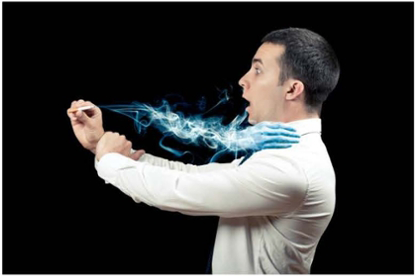TRDRP funding on thirdhand smoke (THS) research has revealed potential human health risks due to exposure in smoked indoor settings. The U.S. Department of Housing and Urban Development (HUD) relied heavily on TRDRP-funded research to initiate its effort on THS in low income housing. This research has also supported passage of “no smoking in family child care homes” law in California in 2014.
— TRDRP-funded research recently influenced the U.S. Department of Housing and Urban Development (HUD) to invest resources in investigating the potential health impact of exposure to thirdhand smoke (THS) and developing cleaning techniques to reduce THS residues from surfaces in homes.
— TRDRP-funded THS research contributed to the passage of California legislative bill AB 1819 in 2014 that prohibits smoking tobacco at all times in the homes of licensed family child care homes and in areas where children are present.
Whenever a cigarette is smoked indoors a part of the smoke settles on the indoor surface. Over time this residue called thirdhand smoke (THS) creates new toxic pollutants, harmful volatile chemicals and potentially cancer causing agents (Sleiman et. al., 2010). Researchers have now identified several THS constituents as potentially harmful especially to newborn infants and children.
Consistent with the program’s focus on emerging and under-researched areas, TRDRP has invested significant funding in THS research since 2010. A statewide research consortium of eight research groups is working in an interdisciplinary manner to unravel THS characteristics and potential risks to human health.
Below are some key thirdhand smoke research findings supported by TRDRP:
- THS may affect human health through damaging DNA, our genetic material, resulting in cancer or other diseases. Also, related studies funded in part by TRDRP, have now shown that newborn infants are exposed to nicotine in smoking households via THS exposure. (Hang et. al., Mutagenesis. 2013 Jul; 28(4):381-91) (Northrup et. al., Tob Control. 2015 Dec 3)
- This TRDRP-funded study found that California hotels with non-smoking rooms fail to protect non-smoking hotel guests from tobacco smoke exposure. The investigators also devised a method to detect THS contamination on surfaces in homes, cars and hotels. (Matt et. al., Tob Control 2014; 23:264-272)
- TRDRP-funded investigators have recently published on the challenges of limiting exposure to THS in vulnerable populations. On the basis of their survey results, the authors offer public policy approaches to managing THS. For example, a majority of realtors (73 %) agreed that property previously occupied by smokers was a concern for buyers, and that buyers with children were especially discouraged (67 %). It is also noted that previous smoking in a home has a notable impact on real estate transactions. (Samet et. al., Curr Envir Health Rpt (2015) 2:215–225)
- As THS gains broader public awareness as a potential hazard, researchers at UCSF are studying how well the existing federal policies on housing are protecting military families and personnel from secondhand or thirdhand smoke. Their work forms the basis of recommendations putting forward the need for a consistent policy for tobacco-free military living quarters. (Smith et. al., Mil Med. 2015 Jun; 180(6):612-4)
- In an effort to design approaches to remediation, i.e. how to get rid of THS constituents from indoor surfaces, researchers at UC Riverside have reported how THS deposition varies between cotton terry cloth and polyester fleece. They also document how nicotine exposure from THS residue can be 6.8 times higher in toddlers and 24 times higher in adults than what would be inhaled by a passive smoker. (Bahl V. et. al., PLoS One. 2014 Oct 6; 9(10):e108258)
Researchers from the United Kingdom and Spain have also reported that exposure to nitrosamines in THS increases cancer risk in non-smokers (Ramirez N et al., 2014). Although scientific evidence regarding human health effects of e-cigarettes is still in its infancy, recent reports raise concerns on how exposure to residual vapor constituent from electronic cigarettes may act similarly as THS exposure (Goniewicz et.al. 2014) (Callahan-Lyon 2014).
As data on the risk to human health of THS continues to be developed, this information serves as additional evidence for promoting smoke-free homes in low-income communities as well as a another reason to quit smoking.

